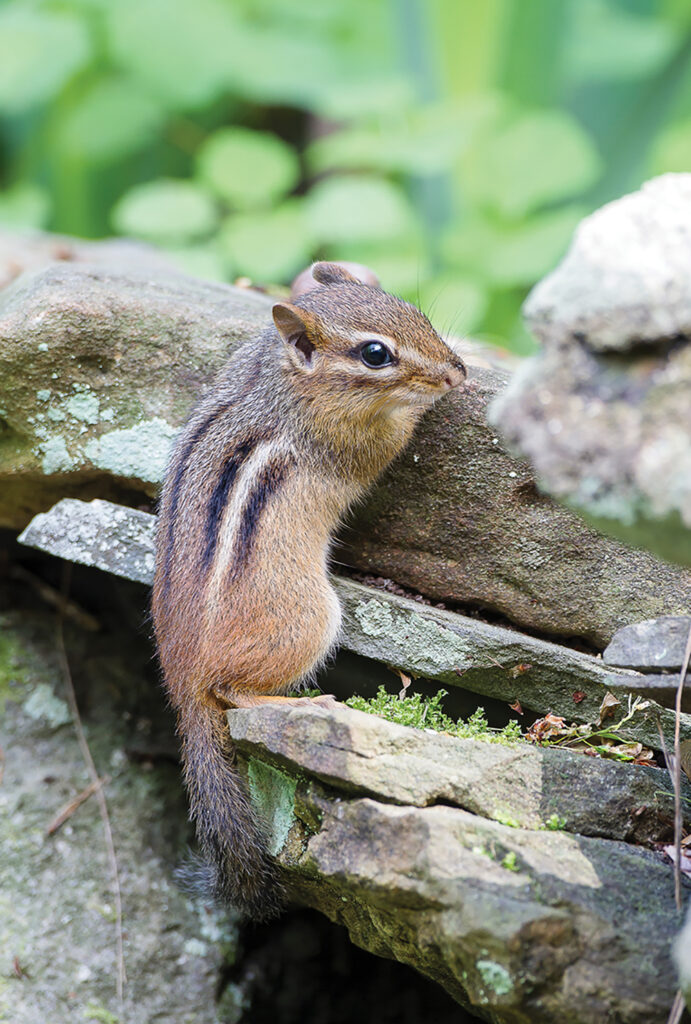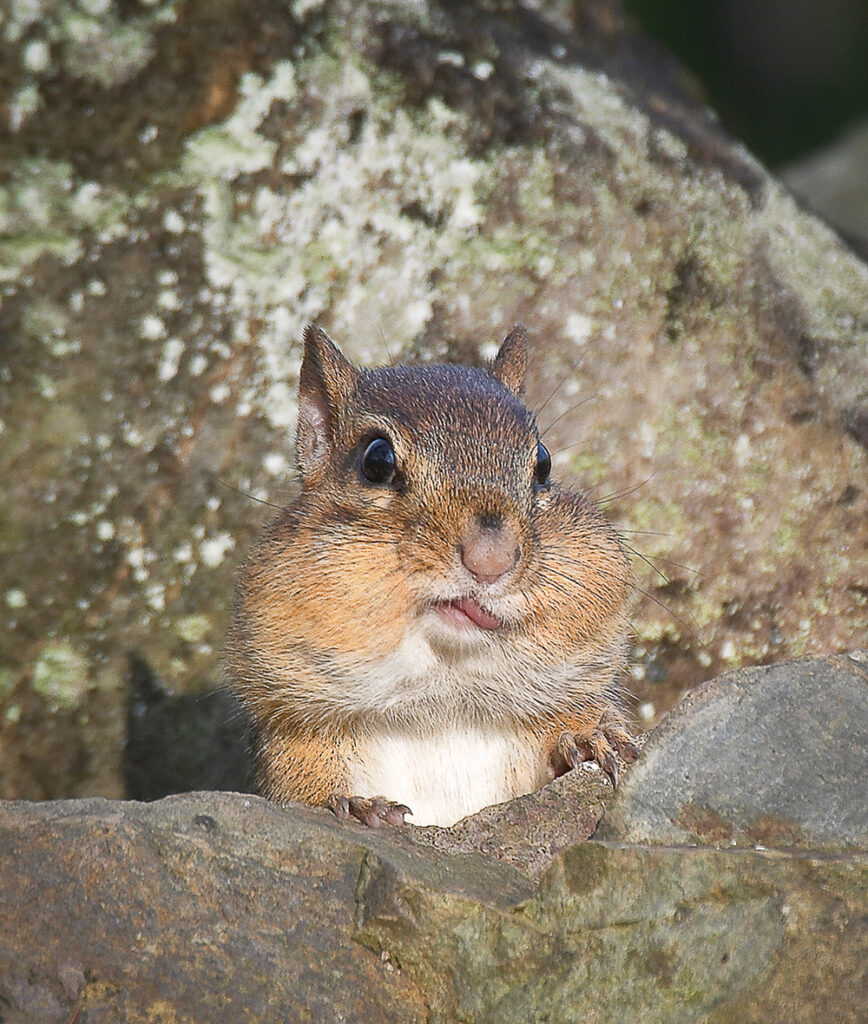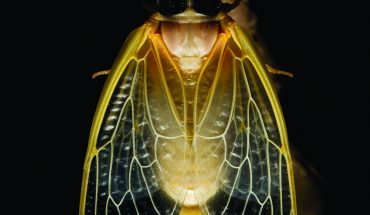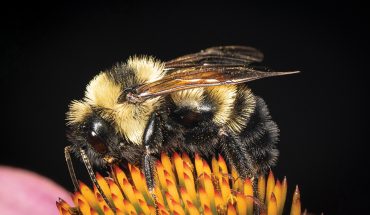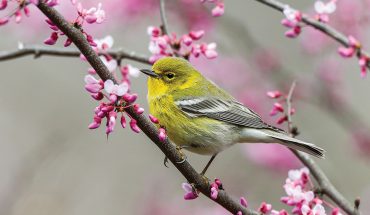The Eastern Chipmunk can hold 60 sunflower seeds in its expandable cheek pouches and builds 10-foot-long tunnels.
Words and photographs by Mike Dunn
Our home has a lot of windows, so we can look out and watch the goings on of our wild neighbors in the yard. After living on this property for several years, I looked out one morning and saw a brown blur racing from a stone wall to a small footbridge.
What was that? It moved so fast as it darted between the plants and under the bridge. In a few seconds, I knew the answer: our first chipmunk! I was hooked — chipmunk watching can be addicting. A few days later, there were two dashing around the yard and, ever since, I have enjoyed observing their antics as they go about their busy lifestyle. I later learned that a group of chipmunks is called a scurry, an appropriate name for these critters, which I think are the cutest of all our native wildlife species.
Chipmunks are a type of small ground squirrel, measuring only 8 to 10 inches in total length, including about a 4-inch tail. There are over 20 species in the United States, but our only species here in the Piedmont is the Eastern Chipmunk, Tamias striatus.
The genus name, Tamias, is Greek for “storer,” and describes their habit of squirreling away large quantities of food in their burrows. The species name, striatus, means “striped,” and refers to their most recognizable physical trait — the alternating dark and light stripes on their cheeks and back.
The word chipmunk is from a Native American word meaning “one who descends trees headfirst.” Though they are ground squirrels, I have witnessed them run up a tree trunk when startled. They also climb to seek nuts or seeds or get a better vantage point to chew on an acorn or scan their territory.
Another notable feature of chipmunks are their expandable cheek pouches, which they can stuff with
seeds, nuts, berries and other food. Each pouch has an opening between the jaw and the cheek that can expand to be the size of half a ping-pong ball. I enjoy watching our “chippies” (a word that I now can’t help calling these little dynamos) run around as they gather nuts and seeds and stuff them in their pouches until their heads are almost three times the original size.
Observers have counted as many as 60 sunflower seeds or three acorns being stuffed into one pouch. The quantity they can gather in a short time is impressive. One person recorded a chipmunk hoarding 150 acorns in one day. And famed 19th-century naturalist John Burroughs once observed a chipmunk collect and store 5 quarts of hickory nuts, 2 quarts of chestnuts, and a large amount of shelled corn — almost a bushel of food.
The pouches are emptied by squeezing with their front feet. Cheek pouches allow chipmunks to quickly gather large amounts of food in preparation for winter and thereby reduce the amount of time they are out in the open exposed to predators.
Chipmunks always seem to be on the lookout for potential danger — probably because they’re on every predator’s dinner menu (hawks, foxes, coyotes, snakes and free-ranging house cats are local dangers). Chipmunks make warning calls to alert others of the presence of predators.
Researchers have discerned three main types of alarm calls given by Eastern Chipmunks: a chip-trill — a short high-pitched call made while running to defend territory or escape predators; a high-frequency chipping call made from a stationary position like a prominent rock or log that indicates a threat from a terrestrial predator; and a lower-frequency chucking call when facing a threat from an aerial predator like a hawk (again made while stationary).
The repeated low-pitched clucking note of chipmunks is a woodland sound that fooled me years ago when I first heard it, thinking it was some sort of bird. Now when I hear it, I scan the sky for hawks. Once they are spooked, a chipmunk can disappear in a hurry, scampering to their burrow or other shelter, tail held high.
Chipmunks are most active early in the morning, with another peak in late afternoon. I see them forage all across the yard and nearby woods, but they are particularly fond of the areas around the bird feeders (no surprise there) and the rock walls around our two ponds. They have regular paths they take to and from their burrows as they forage. Burrows can be extensive, especially for the females.
A tunnel system can consist of several entrances (a main entrance and some escape exit holes) extending a few feet underground and spanning 10 or more feet in length. They may have multiple underground chambers for different purposes like food storage, raising their young, sleeping or even an outhouse. It can be difficult to find a chipmunk burrow since they usually carry away the excess dirt in their cheek pouches, leaving no obvious mound of dirt at the entrance.
Plus, they often disguise their burrow entryways. Two years ago, we started finding 1 1/2- to 2-inch holes in our gravel walkway off our deck. One would appear, then get filled in, and another would pop up. We suspected chipmunks, but it wasn’t until I put a trail camera on one of the holes that it was confirmed. A chipmunk was indeed going in and out and would periodically drag leaves, sticks and even rocks over to hide the hole.
The tunnel system is particularly important in winter, when chipmunks go into torpor, a hibernation-like state of suspended activity with reduced heart rates, body temperature and breathing. Since chipmunks don’t develop a huge layer of body fat like bears do for the winter, they must wake periodically to eat some of their stored food and void waste products.
They may stay awake for several days and even wander above ground during warm winter weather. I have even seen chipmunk tracks in the snow in our yard (you remember snow, don’t you?) after a January thaw.
Chipmunks breed in early spring and often again in summer, producing broods of three to five babies. The females nurse their young underground until they venture out after six to eight weeks. I remember seeing the first baby chipmunks in our yard over a decade ago — four bundles of energy about two-thirds the size of the adults, zigzagging everywhere as they chased and tumbled with each other.
Soon after, they were on their own, finding new territories and digging their first burrows. Home range is usually pretty small, often only a third of an acre up to about an acre, depending on food availability. Life expectancy in the wild is two to three years.
The distribution of chipmunks in our state is highly variable — some suitable habitats in Wake County
have an abundance, others none. Until recently, they were not found in the Coastal Plain, but have shown up in the Wilmington area in recent years (in fact, eight new counties were added to their range in 2021). Found in both urban and rural areas, they prefer open woodlands and forest edges with dry ground for digging their burrows.
Some days I see two or three chippies darting about the yard and it just makes me smile. I know that a few people dislike these little guys as they may steal a snack out of your garden, but, so far, we have lost only a few bites from low hanging tomatoes and the occasional bean to our chippies. So I, for one, am
glad they have decided to chip and cluck in our woods.
This article originally appeared in the May 2023 issue of WALTER magazine.

